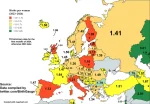Aktywne Wpisy

badreligion66 +355

źródło: temp_file302753039126793122
Pobierz
mirko_anonim +43
✨️ Obserwuj #mirkoanonim
Usunąłem tu konto, więc nie wrzucę znaleziska, ale dla tematów demograficznych poświęcam się i wrzucam z anonima. Zanosi się, że na 2024 Polska będzie miała najgorszą dzietność w Europie. Obecnie jest to 1.1 jak widać. Ciekawe kiedy TFR tgeo narodu spadnie poniżej 1.0, może jak dopompujemy deweloperom to się polepszy?
#nieruchomosci #demografia #ekonomia
────────────────
Usunąłem tu konto, więc nie wrzucę znaleziska, ale dla tematów demograficznych poświęcam się i wrzucam z anonima. Zanosi się, że na 2024 Polska będzie miała najgorszą dzietność w Europie. Obecnie jest to 1.1 jak widać. Ciekawe kiedy TFR tgeo narodu spadnie poniżej 1.0, może jak dopompujemy deweloperom to się polepszy?
#nieruchomosci #demografia #ekonomia
────────────────

źródło: total-fertility-rate-in-europe-2023-4-data-v0-75tkkqth5kzc1
Pobierz




===
Architecture of the type IVa pilus machine
SUPER! Irreducible complexity ( ͡° ͜ʖ ͡°)
Rotary Motor
The motor is thought to control whether the pilus is being extended or contracted at any moment. Individual pilin subunits are embedded in the membrane. A small asymmetric protein in the motor, termed PilC (colored red in the illustrations), has a cavity on one side that cups the end of the filament. Researchers have proposed that as the motor turns, PilC forces the filament up, opening space for a new pilin subunit to associate. To shorten the filament, the motor appears to switch direction, popping pilin subunits one at a time back into the membrane.
The pilin subunit has a distinctive structure. It has a globular head that is covered with charged, water-soluble amino acids (shown here in magenta), and a long alpha-helical tail that is mostly hydrophobic (shown in white). The hydrophobic tail plays two roles: it embeds the individual pilin subunits into the bacterial membrane, and it forms a tight bundle with other pilin subunits to stabilize the filament. To explore of pilin and the filament (PDB entry 2hil) in more detail, click on the image for an interactive JSmol; http://pdb101.rcsb.org/motm/211
#nauka #biologia #ciekawostki